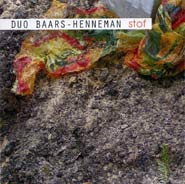Duo Baars - Henneman
Stof
(Wig)
Musicians with a multi-decade career, Ab Baars and Ig Henneman are in
many ways artists who can be said to be quite typical of a way of conceiving
music that is peculiar to Holland, from the variety of their stylistic
background to their adventurous attitude in combining composition (including,
of course, the avant-garde of the XX century) and improvisation. A saxophone
and clarinet player, Ab Baars is still maybe known more for his work with
the long-standing line-up called Instant Composers Pool Orchestra than
for the work done with the more compact groups he has lead for quite some
time now. A viola player of stunning technical ability, Ig Henneman has
led (and recorded with) a whole series of different line-ups, from string
quartets to quintets to tentets (and what's more Dutch-like than those
multi-stylistic tentets that feature strings and winds?).
Stof
is a duo work largely made up of improvisations. There are also some composed
moments, though, and I also believe that at certain points an ingenious
editing work has given an "after the fact" shape to some transitions
(and: am I hearing double, or there really is an - albeit tiny - use of
overdubbing?). As per her usual, Henneman plays the viola, while this time
Baars plays also the shakuachi and the noh-kan - a short transverse Japanese
flute of ancient and noble origins (I did a web search) - besides his usual
tenor sax and clarinet.
With
only one exception, all tracks (fourteen in less than one hour) are on
the brief side. All superfluous material is absent, with a lot of conceptual
reasoning as the basis for the playing. The album is not at all "difficult".
It just demands a lot of attention, the right disposition towards the act
of listening, and a quiet room. As a good for instance, one can consider
the melody played by the clarinet in the high register in the track that
opens the album, Eye Dazzler: while played, say, two octaves below on an
instrument like an accordion or a piano it would be easy to be seen as
the beautiful melody that it is, as played here it requires just the right
approach on the part of the listener. This is true of the album as a whole:
while it's not devoid of more accessible moments, it really needs sympathetic
ears that won't mistake aesthetical austerity with emotional lack of involvement.
There
are goods moments aplenty here. Check the almost rural melody painted by
the noh-kan, with a raw-sounding viola opposing it, in Tackety Dancing
Shoes. Or the many registers of the tenor, and the viola forming mournful
airs, in Violetto Rossastro. The hushed tones of the shakuachi in Giallo
di Napoli. The track for viola solo, Whirligig, where some thematic variations
are quite easy to perceive, and where there is a beautiful musical episode
with long, held notes with vibrato before the theme at the end. Or Ruby
Slippers, chamber-like with clarinet, one of the pieces I liked the best
on the CD. The strong, repeated, rhythmic figures by the viola, played
pizzicato, and the
"cool" tenor sax, blown, in Castle Walk In Herringbone Suit. The
homage to Stravinsky (I suppose!) in Igor's Bransle. The meditative and microtonal
Grigio Perla Per Noguchi. Or the ever-changing long track, Stof - To Eiske,
which has its start in the body of the viola being hit and arrives at a point
where the viola gives pedal points to a "cool" clarinet sounding
quite Ellington-like.
Beppe
Colli
©
Beppe Colli 2007
CloudsandClocks.net | Jan.
7, 2007











